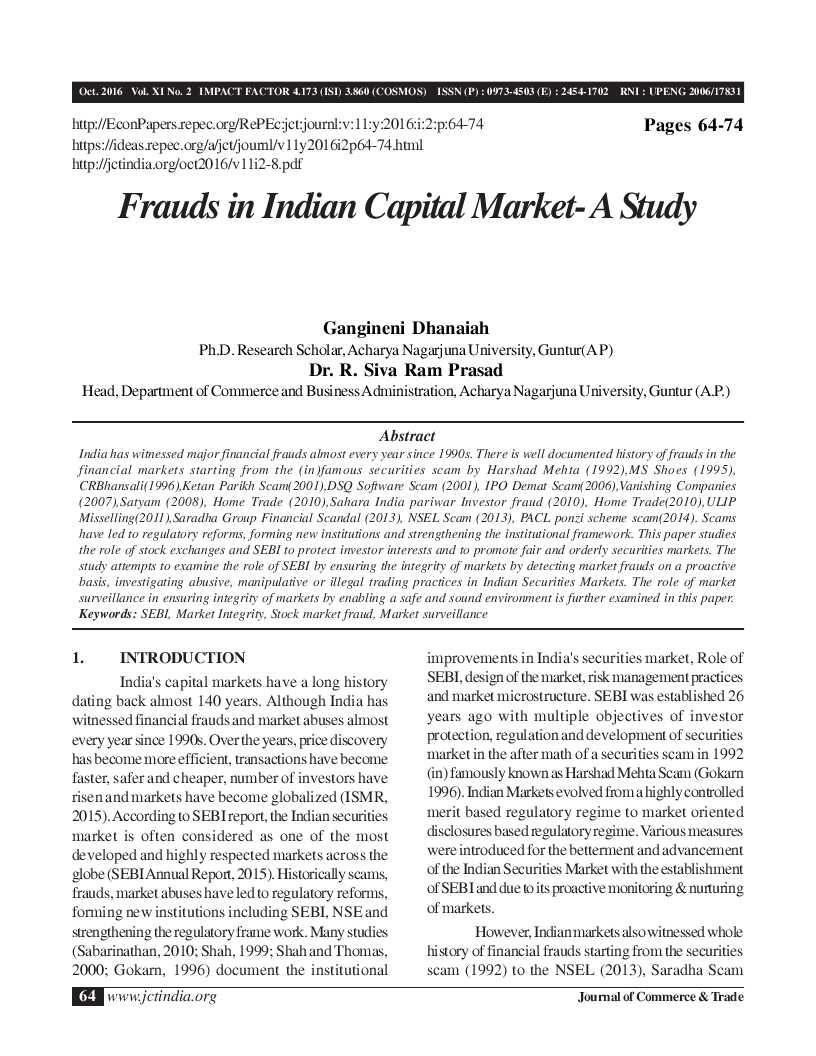Frauds in Indian Capital Market- A Study
DOI:
https://doi.org/10.26703/jct.v11i2.212Keywords:
SEBI, Market Integrity, Stock Market Fraud, Market SurveillanceAbstract
India has witnessed major financial frauds almost every year since 1990s. There is well documented history of frauds in the financial markets starting from the (in)famous securities scam by Harshad Mehta (1992),MS Shoes (1995), CRBhansali(1996),Ketan Parikh Scam(2001),DSQ Software Scam (2001), IPO Demat Scam(2006),Vanishing Companies (2007),Satyam (2008), Home Trade (2010),Sahara India pariwar Investor fraud (2010), Home Trade(2010),ULIP Misselling(2011),Saradha Group Financial Scandal (2013), NSEL Scam (2013), PACL ponzi scheme scam(2014). Scams have led to regulatory reforms, forming new institutions and strengthening the institutional framework. This paper studies the role of stock exchanges and SEBI to protect investor interests and to promote fair and orderly securities markets. The study attempts to examine the role of SEBI by ensuring the integrity of markets by detecting market frauds on a proactive basis, investigating abusive, manipulative or illegal trading practices in Indian Securities Markets. The role of market surveillance in ensuring integrity of markets by enabling a safe and sound environment is further examined in this paper.
Downloads
Metrics
References
_______(December 2009). Approaches to Market Surveillance in Emerging Markets. SPAIN: OICV-IOSCO.
Ajay Shah, S. T. (2008). India's Financial Markets. Gurgaon, India: Elsevier.
Echeverri-Gen, J. Politics of Market Micro-Structure. In India's Economic Transition (pp. 328-357).
Franklin Allen, R. C. (2007). India's Financial System.
Gokarn, S. (1996). Indian Capital Market Reforms, 1992-96: An Assessment. Economic and Political Weekly, 956-961.
Goyal, A. (2004). Regulation and De-regulation of the Stock Market in India. 1-28.
Ila Patnaik, A. S. (2014). Reforming India's Financial System. Carniege Endowment for International Peace.
Institutional Investor Advisory Services. (2013). Capital Market: Frauds and Malpractices. Mumbai: PHD Chamber of Commerce.
Jalan, B. (Nov 2010). Review of Ownership and Governance of Market Infrastructure Institutions. Mumbai: www.sebi.gov.in.
Kumar, S. (2015). The Changing Face of Trade Surveillance and the Role of Analytics. Mumbai: Tata Consultancy Services.
Narayanan, S. (2004). Financial Market Regulation-Security Scams in India with historical evidence and the role of corporate governance. http://mpra.ub.uni-muenchen.de/4438/.
NSE. (2009). NCFM-Surveillance in Stock Exchanges Module. Mumbai: National Stock Exchange of India.
Örtenblad, J. (2001). Market Surveillance System. KTH (departments of Financial Mathematics and Microelectronics and Information Technology).
Sabarinathan. (Oct-Dec 2010). SEBI's Regulation of Indian Securities Market: A Critical Review of Major Developments. VIKALPA, 13-26.
SEBI. (2015). SEBI Annual Report 2014-15. Mumbai: Securities and Exchange Board of India.
Shah, R. R. (2005). New directions in Indian financial sector policy. In P. Basu, India's financial sector: Recent reforms, future challenges (pp. 54-87). Macmillan India.
Thomas, A. S. (2001). Policy issues in Indian Securities Market.
Thomas, A. S. (2001). The evolution of the securities markets in India in the 1990s. 1-26.
Yogesh Kumar Chauhan, K. K. (2012). Market Imperfections and Regulatory Intervention: The Case of Insider Trading in Indian Stock Market. www.ssrn.com.

Additional Files
Published
How to Cite
Issue
Section
License
Copyright (c) 2016 Journal of Commerce and Trade

This work is licensed under a Creative Commons Attribution 4.0 International License.







